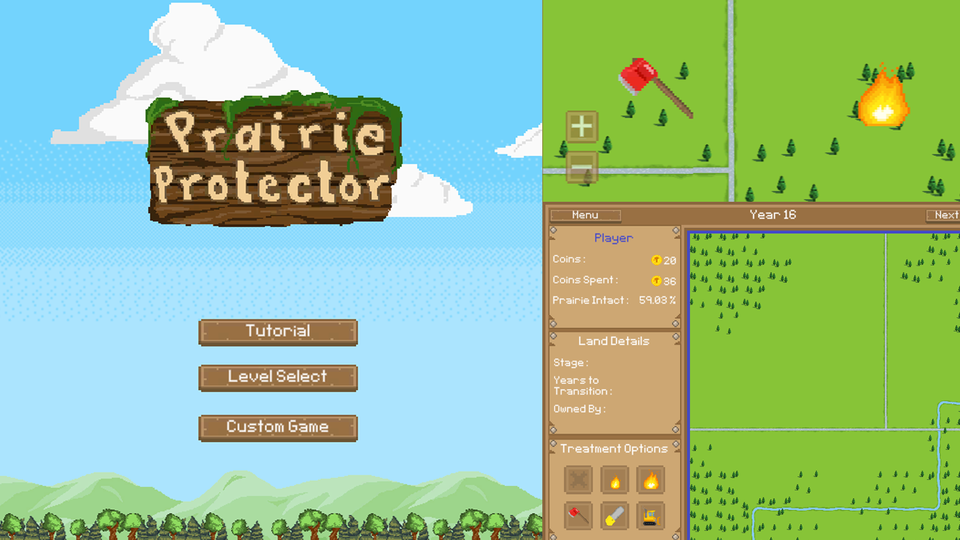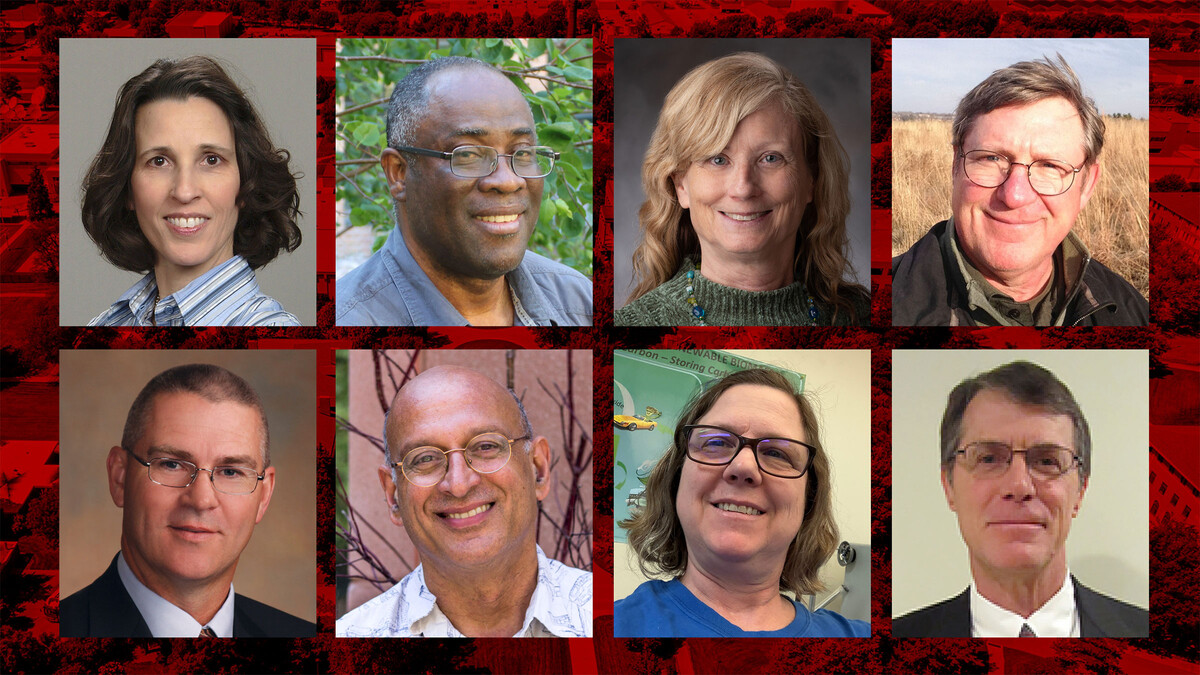
Lincoln, Neb. —More than two years in, Jenny Keshwani has cleared countless prairie acres of the eastern redcedar tree.
The invasive species, dubbed the “green glacier” for the way it has overrun native grasslands throughout much of the Great Plains, is now threatening to do the same in Nebraska. So Keshwani has taken up the ax, chainsaw, bulldozer and, when she has enough coin, controlled burns of purging fire to obliterate the menace.
Now high schoolers across the Cornhusker State are joining Keshwani in lifting a finger for the cause: eradicating swarms of pixelated evergreens from a screen via the click of a mouse.
That’s the charge presented in Prairie Protector, a computer game conceived by University of Nebraska–Lincoln faculty and developed by Husker undergrads from the School of Computing, Department of Biological Systems Engineering and Hixson-Lied College of Fine and Performing Arts. The game’s simple 2D graphics and gameplay mechanics belie a grander vision: spreading the word about an invader that is endangering native plant and animal species, the livelihoods of ranchers, even the financial security of Nebraska’s public schools.
Keshwani“It gives students a really tangible way to see the impact on their own environment,” said Keshwani, an associate professor of biological systems engineering and science literacy specialist with Nebraska Extension. “When we’ve talked to students after they’ve played Prairie Protector, they start noticing (that), yeah, there is invasive redcedar all over the place. It wasn’t there a few years ago, but now it is.”
As little as a few years ago, eastern redcedar was a stranger to Keshwani, too. But her expertise in translating university research for K-12 audiences brought her to the attention of Dirac Twidwell, an associate professor of agronomy and horticulture who has spent years studying and working to slow the spread of the invasive species. Keshwani agreed to join The Prairie Project, a multi-state research, education and outreach effort aimed at mitigating threats to the grasslands of the Southern Great Plains.
While doing their homework on eastern redcedar, Keshwani and colleague Erin Ingram came across a blog post that compared its encroachment to the 1978 arcade classic Space Invaders.
“I remember being a little kid playing Space Invaders,” said Keshwani, who was previously involved with another Husker-developed game, Agpocalypse 2050. “It resonated with me.”
Inspired, she was soon partnering with a group of five Husker students led by Conner Lunn, a recent Nebraska graduate, to develop a game that instead had players fighting off a terrestrial invader.
In the course of their research, Twidwell and his colleagues had developed mathematical models of eastern redcedar’s spread that Keshwani and the students used to calibrate the pace of its propagation in the game. That research likewise led the team to implement three stages of invasion, only the latter two of which can drop seeds — making them strategic targets for players looking to stop the spread.
“Anytime we develop a game, we want to make sure it’s true to the science,” Keshwani said.
The science also helped the team decide on the type and effectiveness of treatment methods included in the game. Hand-cutting with an ax keeps young trees from growing into mature, seed-producing ones, whereas bulldozing can clear out those mature specimens or even an entire woodland. But none of those mechanical methods can delay the sprouting of new eastern redcedar. Controlled burns, meanwhile, will stymie new growth for at least a few rounds, giving players valuable time to start clearing other areas of the map.
“The challenge was just having the right balance of complexity, as well as something that students could really understand,” Keshwani said. “This system is very complex, but we were able to simplify it to: You have trees, and you have tools, and you’re trying to (eliminate) those trees, but they’re spreading seemingly randomly and quickly across the landscape.”
Because more than 95% of Nebraska’s land is privately owned, Keshwani was also keen on placing players in the boots of a landowner surrounded by “people who have a lot of different constraints and personalities.” Though developing a multiplayer mode was ultimately too tall a task, the game does allow players to add AI-controlled neighbors on adjacent plots of land. Giving those neighbors different mentalities — one may clear the center of their land but allow redcedar on a border to spread onto the player’s territory, while a more conscientious neighbor will clear their perimeter and work inward — helps recreate the human element, Keshwani said.
“A big part, when we develop a game, is making sure that the players develop some empathy for the different participants in the real-world scenario,” she said. “By playing as a land manager, you’re no longer like, ‘OK, these people over here should make decisions this way, because that’s what’s best for the environment.’ Yeah, it’s better for the environment, but they only have so much time, they only have so much money, and they have neighbors who are going to be making other decisions. There are all these other considerations that need to be taken into account.”
Within six months, the team had developed a playable pilot version of Prairie Protector. Alongside extension educators from Texas A&M University and Oklahoma State University, Keshwani first shared the game with about 40 teachers who were integrating eastern redcedar into their curriculum. Feedback from those teachers and their students, which included early input from Hastings Middle School, guided the team as it refined the game.
By early 2022, Keshwani was sharing it with a broader array of high schools. In May, Kearney High School took part in a focus group. An educator from Arkansas, who recently learned about the game via Twitter, plans to try it out with college students.
Many students, Keshwani said, have described a “weird disconnect” when learning that trees — nearly always seen as a universal good — can become the villain when encroaching on grassland ecosystems. That disconnect can emerge, too, when explaining how important controlled fires can be in restoring a landscape to its natural state.
“It’s fun to share the game, because what I’ve heard from students and teachers is that they enjoy it, and they’re learning about the things that we want them to learn about,” Keshwani said. “They’re understanding why it’s tricky to take care of these invasive species. They’re learning different strategies for how to contain them.
“It’s a big problem, and talking with our collaborators in Texas, in Oklahoma, they are so much further into the invasion that it’s almost a lost cause. So being able to spread the awareness today, where there’s still an opportunity to do something (in Nebraska), is exciting, especially when youth see themselves as having some agency in that decision-making process.”
Even after all of the development and fine-tuning and playing, Keshwani said she continues returning to the game.
“I still enjoy it, even though I know what I’m supposed to do, all the ins and outs,” she said.
And if her experience with the game is any indication, the combination of knowledge, practice and dedication should give Nebraska’s conservationists and landowners a reasonable shot at protecting their prairies.
When Keshwani first began playing, eastern redcedar would often end up overwhelming her digital plots of land. Now?
“I usually win.”
To play Prairie Protector, visit www.prairieprotector.com.







